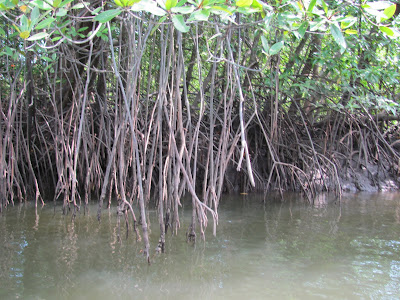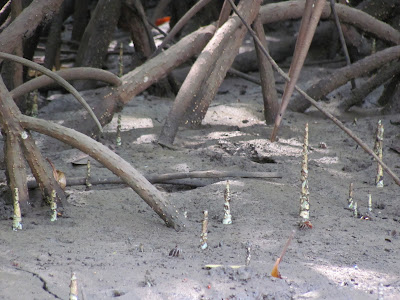Mangroves are common in the protected coasts in Central America and the Caribbean(they are also found in Florida and other regions of the Gulf Coast in the US). However, mangrove ecosystems in the Caribbean contain many fewer species than mangrove ecosystems in the tropics. For example, there are three main species of mangroves found in the Caribbean region whereas there can be as many as 58 species of mangroves found in the Indo-Pacific region.
Problems Facing Plants Licving in Intertidal Areas
Plants living in intertidal environments face a number of problems. First, because the soil is very fine and water logged, it is difficult for the root system to support the plant. Second, because the roots zone is waterlogged, plant roots are unable to pick up the oxygen they need through the woil. Finally, because they are living in the intertidal zone mangrove plants have to be able to live in water with high salt concentrations.
Mangrove Roots
Because mangroves live in waterlogged, unconsolidated soil, they have to have specialized root systems to support themselves.
Trees that live on land usually have a number of roots below ground that join into a single trunk that extends above ground. As you can see from these photos, the growth form of mangrove plants is very different. A large number of roots branch off from the trunk and then grown down into the soil. These roots, known as prop roots, help to stabilize the trees.

Some mangrove trees produce "aerial roots" that drop down from branches until they reach the soil. One they reach the soil they help to support the tree.


Adaptations For Picking Up Oxygen
Remember that, unlike us, plants don't breathe. Plant leaves produce the oxygen they need as a byproduct of photosynthesis. However, because they are underground and not exposed to light, plant roots are unable to conduct photosynthesis so they have to rely on picking up oxygen from the surrounding soil by diffusion. On land the air spaces between soil particles provides the oxygen that the plant needs. However, in waterlogged soils, water replaces the air in the spaces between the soil particles so there is no oxygen available to the plant roots. Because plants don't have a circulatory system, there is no way for them to quickly move oxygen from the leaves to the roots. Thus, mangroves have evolved interesting adaptations to provide oxygen to their roots.
Some mangrove plants produce interesting structures known as pneumatophores. Pneumatophores are structure that grow up out of the soil high. These pneumatophores allow the plants to pick up oxygen from the air that can be used by the roots.

The shapes of pneumatophores differs between species.

The white blotches on the prop roots are structures known as lenticels. The lenticels are connected to the underwater roots by a spongy tissues that allow oxygent that diffuses into the prop roots through the lenticels to diffuse easily to the roots where it is needed.

Importance of Mangroves
Mangroves are being destroyed around the world at a rapid rate. Mangroves are destroyed to allow for coastal development or aquaculture. In Malaysia there have been many stories in the newspapers about illegal wood cutting in Malaysian mangroves.
Mangroves are very important ecosystems for two reasons. First, they serve as nurseries for a number of marine fish and invertebrates. The jeuveniles of many species hide out among the mangrove roots until they are large enough to move out to the reef. Second, the mangrove roots protects the shore from the effects of storms and tsunamis. It was well documented that regions that were protected by mangroves were much less negatively affected by the big tsumani than those regions where the mangroves have been removed. I was very pleased that this tour exposed people the to beauty and importance of the mangrove ecosystem. I hope that all of you that live in the tropics remember to give your mangroves some love.
To learn more check out-
http://www.eoearth.org/article/Mangrove_ecology?topic=49514

No comments:
Post a Comment